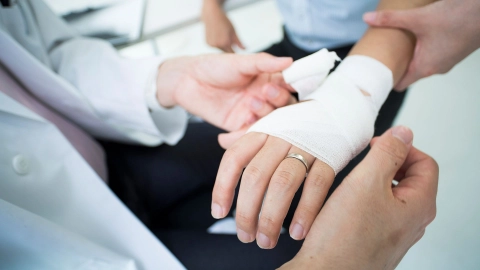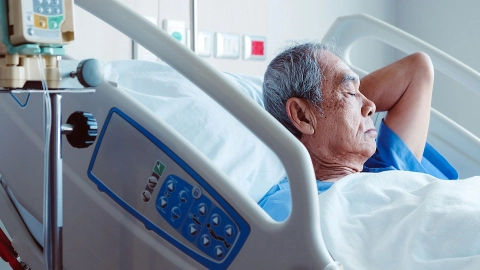Conditions Chronic wounds
ICD codes: L98 What are ICD codes?
Minor everyday injuries usually heal quickly. However, a wound can be very slow to close or keep re-opening. If the wound does not heal within four to twelve weeks despite treatment, it is referred to as chronic. The treatment of chronic wounds is usually long and painful.
At a glance
- A wound is referred to as chronic if it does not heal within four to twelve weeks despite treatment.
- Treating chronic wounds can take a long time and is often painful.
- Difficult to heal wounds are frequently caused by circulatory disorders or diabetes mellitus.
- Chronic wounds often develop on the feet or lower leg.
Note: The information in this article cannot and should not replace a medical consultation and must not be used for self-diagnosis or treatment.

What is a chronic wound?
Whereas most minor everyday injuries heal quickly, it can take longer for larger wounds to heal. These types of wounds sometimes require stitches.
It can also happen that wounds close very slowly, continually recur or do not heal at all. In most cases this is due to circulatory disorders or diabetes mellitus. Difficult to heal wounds often occur on the feet or lower leg.
A wound is referred to as chronic if it does not heal within four to twelve weeks despite treatment. Treating chronic wounds can take a long time and can be painful. Getting the right wound care is very important here. The underlying condition that favored the wound should also be treated.
What are the symptoms of a chronic wound?
Chronic wounds can be very painful as tissue and nerves are damaged. The size and depth of a wound determines how painful it is.
However, people with a diabetic foot often do not feel any pain as the nerves are so impaired that they barely transmit any pain stimuli.
If a wound stays open for a long period the skin around the wounds may turn a reddish or brownish color. The wound may also itch, weep or have an unpleasant odor.
The pain may be exacerbated if the wound becomes inflamed or the affected body part is moved. Many people with chronic wounds sleep badly at night because this is when the pain and itchiness are at their most intense.
What are the causes of chronic wounds?
Wounds are often the result of an injury such as a cut or hard knock.
People who develop a chronic wound often have an underlying condition, however. They are more prone to wounds which are difficult to heal. These underlying conditions or health problems include, for example:
Circulatory disorders
People with narrowing of the arteries (blood vessels that supply body tissue with oxygen and nutrients) generally find that their wounds heal more slowly than those with good circulation. Peripheral artery disease (PAD) is a typical underlying condition.
Venous insufficiency
Wounds on the lower leg or foot also tend to be difficult to heal in people who have problems with the veins in their legs. The veins in the legs transport the blood back to the heart. If the venous valves are not working properly the veins become distended. The blood accumulates in the legs and they swell up.
This leads to an increase in pressure which stops blood circulating properly, cutting the supply of oxygen to the body’s tissue. It may also lead to varicose veins. Under these adverse conditions a minor injury can turn into a chronic wound. A difficult to heal wound on the lower leg is commonly referred to as a leg ulcer.
Diabetes
Typical signs of the advanced stages of diabetes are damage to the blood vessels and nerves in the feet. This is why people with diabetes often do not feel pain in their feet. As a result they can easily fail to notice minor injuries or pressure points caused by shoes that are too tight. Poor circulation also interferes with the supply of blood to the feet. A “diabetic foot” increases the risk of chronic wounds.
Immune deficiency
People with severe diseases such as cancer, older people or people who are malnourished have weak immune defenses. This may mean wounds can take longer to heal.
Severe injury and soft tissue damage
Large, deep wounds caused by a severe injury or burns are a challenge for the body’s self-healing processes.
Mechanical pressure
When people are bed-bound or sitting in a wheelchair their own body weight exerts a constant pressure on certain areas of the skin. This can cause a pressure sore (bed sore or decubitus ulcer).
Pressure must then be removed from the affected area of the body to allow the pressure sore to close.
What are the potential consequences of a chronic wound?
A chronic wound puts strain on the body and the immune system. This, together with the lack of sleep caused by itchiness, can lead to people often feeling tired and worn-out. The pain also restricts mobility.
If bacteria get into the wound, this can become inflamed and the tissue can die. Without treatment, the pathogens can spread further and a risk of blood poisoning (sepsis) arises.
In the worst case, the affected part of the body, such as the foot, may have to be amputated.
How can chronic wounds be prevented?
It is important to treat underlying conditions that increase the risk of a chronic wound:
- In the case of diabetes, it is important to maintain a healthy blood sugar level. Pressure points on the foot can be avoided by wearing sufficiently large, wide shoes. Washing and applying cream to the feet daily as well as regular medical foot care and checks by a doctor also help to prevent chronic wounds or to detect them in a timely manner.
- In the case of venous insufficiency and varicose veins, compression stockings or elasticated bandages (compression bandages) can reduce the risk of chronic wounds.
- Circulatory disorders can be treated with medication and interventions, for example through vascular dilation surgery. Circulation can also be improved through lifestyle changes, such as more exercise and stopping smoking.
- In the case of care recipients, measures for avoiding bedsores are important. These include relieving strain on vulnerable areas of the body, for example through special mattresses or frequent repositioning.
How is a chronic wound diagnosed?
Superficial wounds or difficult to heal wounds do not necessarily become chronic wounds. So doctors will first of all check how long the wound has been open. They will also identify the risk factors, such as diabetes, an immune deficiency or circulatory disorders.
How is a chronic wound treated?
A dressing is draped over chronic wounds for protection. It is helpful to apply moisturizer to the edge of the wound and the area around it. This relieves itching and stops the skin from drying out.
The dressing should be regularly changed by a medical specialist. This can be painful if tissue sticks to it.
Other treatment options include:
Wound cleaning
When healthcare professionals change the dressing they also clean the wound. “Simple” wound cleaning involves rinsing the wound with a saline or electrolyte solution. This is followed by wound debridement where devitalized (dead) cells or inflamed tissue is carefully removed with tweezers or a scalpel.
The wound site is generally numbed, for example with a special ointment, to prevent pain during debridement. To avoid more severe pain, medication can be taken prior to the debridement. Anesthesia is also an option for major wounds.
Wound dressings
Once the wound has been cleaned, a new dressing is applied. Wound dressings help to keep the wound moist, absorb excess fluid from the wound and protect against infection. Examples of dressings include wet compresses, films and hydrogels.
Technical procedures
Technical procedures are sometimes used in hospitals to encourage wounds to heal:
- Hyperbaric oxygen therapy: patients breathe in oxygen in a special chamber at a high atmospheric pressure.
- Vacuum-assisted closure: a pump permanently drains fluid from the wound.
Skin transplants
Skin transplants (grafts) are another treatment option. They are mainly considered if a wound is very large and cannot close without treatment. Skin is removed from one part of the body, usually the upper leg, and transplanted (grafted) onto the wound. However grafts can also be made of human cell products and synthetic materials.
Medication
The pain caused by chronic wounds is often underestimated. But effective pain relief is very important.
Oral analgesics such as paracetamol or ibuprofen are effective against mild to moderate pain. Many wound dressings also contain ibuprofen. Doctors may prescribe other drugs for more severe pain.
Antibiotics are an option if a wound is infected with bacteria.
More detailed information about treating chronic wounds can be found at gesundheitsinformation.de.
What’s everyday life like with a chronic wound?
A chronic open wound that hurts and itches can disturb sleep and make everyday life difficult. This also applies to pain when cleaning the wound and restrictions to body care, for example when showering.
Persistent pain and limited physical endurance have negative effects on work and private life and may also have a psychological impact. Some people worry that others will notice an unpleasant smell from their wound.
Persons affected by a chronic wound can feel very uncomfortable and may be ashamed. So many of them tend to isolate themselves.
Personal and medical support are therefore very important. Family and friends are important here, as well as general practitioners, outpatient care services and wound care specialists.
- Bowers S, Franco E. Chronic Wounds: Evaluation and Management. Am Fam Physician 2020; 101(3): 159-166.
- Broderick C, Pagnamenta F, Forster R. Dressings and topical agents for arterial leg ulcers. Cochrane Database Syst Rev 2020; (1): CD001836. doi: 10.1002/14651858.CD001836.pub4.
- Deutsche Gesellschaft für Wundheilung und Wundbehandlung (DGfW). Lokaltherapie chronischer Wunden bei Patienten mit den Risiken periphere arterielle Verschlusskrankheit, Diabetes mellitus, chronische venöse Insuffizienz. S3-Leitlinie. AWMF-Registernummer 091-001. 06.2012.
- Fernando ME, Seneviratne RM, Tan YM et al. Intensive versus conventional glycaemic control for treating diabetic foot ulcers. Cochrane Database Syst Rev 2016; (1): CD010764. doi: 10.1002/14651858.CD010764.pub2.
- Gethin G, Cowman S, Kolbach DN. Debridement for venous leg ulcers. Cochrane Database Syst Rev 2015; (9): CD008599. doi: 10.1002/14651858.CD008599.pub2.
- Norman G, Westby MJ, Rithalia AD et al. Dressings and topical agents for treating venous leg ulcers. Cochrane Database Syst Rev 2018; (6): CD012583. doi: 10.1002/14651858.CD012583.pub2.
- Shi C, Dumville JC, Cullum N et al. Compression bandages or stockings versus no compression for treating venous leg ulcers. Cochrane Database Syst Rev 2021; (7): CD013397. doi: 10.1002/14651858.CD013397.pub2.
- The International Working Group on the Diabetic Foot. IWGDF Guidelines on the prevention and management of diabetic foot disease. 2019.
In cooperation with the Institute for Quality and Efficiency in Health Care (Institut für Qualität und Wirtschaftlichkeit im Gesundheitswesen – IQWiG).
As at:





